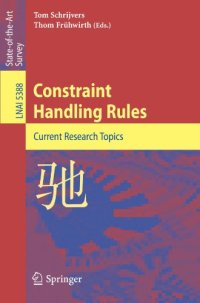
Ebook: Constraint Handling Rules: Current Research Topics
- Genre: Computers // Cybernetics: Artificial Intelligence
- Tags: Artificial Intelligence (incl. Robotics), Mathematical Logic and Formal Languages, Programming Techniques, Algorithm Analysis and Problem Complexity, Database Management
- Series: Lecture Notes in Computer Science 5388 : Lecture Notes in Artificial Intelligence
- Year: 2008
- Publisher: Springer-Verlag Berlin Heidelberg
- City: New York
- Edition: 1
- Language: English
- pdf
The Constraint Handling Rules (CHR) language is a declarative concurrent committed-choice constraint logic programming language consisting of guarded rules that transform multisets of relations called constraints until no more change occurs.
The CHR language saw the light more than 15 years ago. Since then, it has become a major declarative specification and implementation language for constraint-based algorithms and applications. In recent years, five workshops on constraint handling rules have spurred the exchange of ideas within the CHR community, which has led to increased international collaboration, new theoretical results and optimized implementations.
The aim of this volume was to attract high-quality research papers on these recent advances in Constraint Handling Rules. The 7 papers presented together with an introductory paper on CHR cover topics on search, applications, theory, and implementation of CHR.
The Constraint Handling Rules (CHR) language is a declarative concurrent committed-choice constraint logic programming language consisting of guarded rules that transform multisets of relations called constraints until no more change occurs.
The CHR language saw the light more than 15 years ago. Since then, it has become a major declarative specification and implementation language for constraint-based algorithms and applications. In recent years, five workshops on constraint handling rules have spurred the exchange of ideas within the CHR community, which has led to increased international collaboration, new theoretical results and optimized implementations.
The aim of this volume was to attract high-quality research papers on these recent advances in Constraint Handling Rules. The 7 papers are presented together with an introductory paper on CHR cover topics on search, applications, theory, and implementation of CHR.